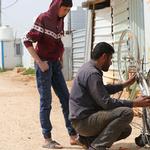Syrian Refugees in Istanbul and Gaziantep: Comparative Findings on Settlement, Livelihood and Support
Figure 1: Locations of Istanbul and Gaziantep
Urban Self-Settlement in Turkey
Urban refugee self-settlement in Turkey is characterised by:
Figure 2: Registered Syrian Refugees in Istanbul and Gaziantep
Figure 3: Gaziantep – Year of arrival in Turkey and year of settlement in neighbourhood
Figure 4: Istanbul – Year of arrival in Turkey and year of settlement in neighbourhood
Kinship ties and networks are key factors influencing urban refugee settlement patterns
Figure 5: Distribution of respondents according to province in Syria
Figure 6: Main attractions of the neighbourhood
Figure 7: Types of cash support distributed according to city
Figure 8: Description for relations with host community-based on number of respondents
How to cite this publication:
Ahmet Içduygu, Souad Osseiran (2022). Syrian Refugees in Istanbul and Gaziantep: Comparative Findings on Settlement, Livelihood and Support. Bergen: Chr. Michelsen Institute (CMI Insight 2022:01)
The Syrian presence in Turkey is largely urban in nature with refugees settling in regional cities along the Syria-Turkey border and in the metropolises of western Turkey. Based on a survey with 300 Syrian refugees in Istanbul and Gaziantep, this CMI Insight discusses the factors influencing refugees’ residence preferences, their living conditions, and highlights access to institutional forms of support.
Figure 1: Locations of Istanbul and Gaziantep
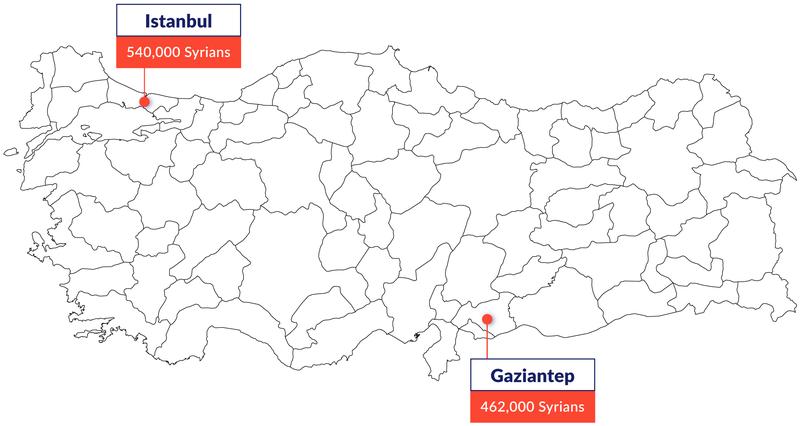
Introduction
The forced migration of Syrians into Turkey began in 2011 after the popular uprising in Syria and is considered a key example of urban self-settlement in a protracted refugee situations. Turkey currently hosts over 3.6 million Syrians registered under Temporary Protection.[1]
Initially perceived as a short-term migration, the Turkish government opened several refugee camps near the Syrian border to host incoming refugees. Nonetheless, refugees began settling in cities near the border with Syria as camp capacities were reached and, the number of refugees registered in Turkey’s western provinces grew alongside concentrations in border provinces.[2] The gradual closure of government-managed refugee camps after 2017 necessitated the further self-settlement of Syrian refugees.
The URBAN3DP survey* was undertaken in the following inner-city neighbourhoods with majority Turkish populations.
Istanbul has a population of over 15,900,000 and hosts over 540,000 Syrians (about 3.4% of Istanbul’s population). Areas surveyed on the European side include Fatih, Zeytinburnu, Esenler, Bağcılar, Küçükçekmece, Sultangazi, and Esenyurt districts. On the Asian side Sultanbeyli and Sancaktepe districts were surveyed.
Gaziantep has a population of around 2,150,000 and hosts 462,000 Syrians constituting about 21.6% of the population. Areas surveyed included Şahinbey and Şehitkemal districts.
* The survey totalled 300 respondents evenly distributed in the two cities. Surveys were collected in Arabic using KoBoToolbox in February 2020. Since the survey was conducted prior to the Covid-19 pandemic, data does not account for the impact of the pandemic and public health measures on respondents in terms of livelihood, expenditures, or debt. 63% of respondents were male and 37% female. Respondent ages were distributed as follows: 18-29 (43%), 30-39 (25%), 40-49 (21%), 50+ (11%). Many thanks for the surveyors for their dedication.
Urban Self-Settlement in Turkey
Urban refugee self-settlement in Turkey is characterised by:
- a high level of refugee registration
- concentration in regional cities along the border region with Syria and major cities including Istanbul, Ankara, and Izmir (see Figure 1)
- self-settlement in select neighbourhoods resulting in urban concentrations and emerging segregation trends
- restricted access to services (healthcare and education) within the province of registration
- continued challenges in accessing formal employment and achieving household resilience
The refugee response in Turkey relied on local actors such as municipalities that faced challenges in identifying support (especially financial) for the provision of services for refugees.[3] The refugee situation in Turkey is further characterised by:
- development of humanitarian and refugee response hubs in regions that had little or no infrastructure for refugee support prior to 2011 (e.g. Gaziantep, Şanlıurfa, and Adana, etc.). This was in contrast to cities where NGOs and civil society support for refugees had been active for many years (e.g. Istanbul, Izmir, and Ankara)
- a growing role for municipalities in implementing refugee policies, despite strong state centralization in Turkey; this growing role developed alongside variations in local-level responses to refugees, service provision, and support infrastructure
- securitization of province-level responses to refugees such as halting refugee registration in specified provinces because of pressure on services and concerns over rising social tensions.[4]
Survey Findings
Istanbul and Gaziantep highlight similar trends in refugee registration in 2016 and 2017 as a result of continued displacement from Syria. Both cities witnessed a slower increase in registration because new registrations were halted and registration transfers stopped in these two provinces as of 2017. Due to the halt in registration and registration transfer,[5] it is estimated that the actual number of Syrian refugees living in either province is higher than the number of registered Syrians.
Figure 2: Registered Syrian Refugees in Istanbul and Gaziantep
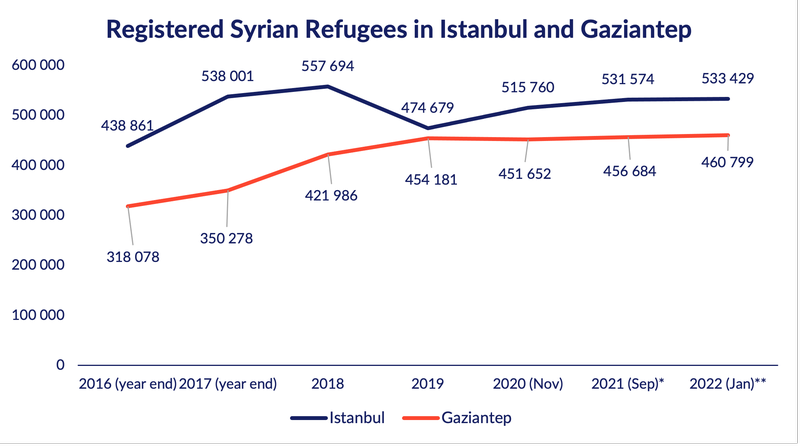 Source: (İçduygu & Altiok 2020); * DGMM September 2021; **DGMM January 2022
Source: (İçduygu & Altiok 2020); * DGMM September 2021; **DGMM January 2022
For 94% of survey respondents, Turkey was the country of first arrival mainly due to the 909 km land border with Syria. In 2014, an increase in forced displacement because of fighting in Syria, as well as easier registration mechanisms across Turkey’s provinces, saw registration rates under Temporary Protection increase rapidly. The gradual decrease in the number of registrations after 2015 occured because of increased restrictions along the Turkey-Syria border including new visa requirements for Syrians as a result of mass migration to Europe through Turkey that year.
Settlement took place more rapidly in Istanbul, as opposed to Gaziantep, wherein there was an initial delay between arrival and settlement (Figures 4 and 5). In Istanbul, refugees prefered to remain in areas of initial arrival where they have kinship or other networks. In contrast, in Gaziantep, some of arriving respondents resided at first in the working-class neighbourhoods before moving to middle-class neighbourhoods as they became more established in the city.
Figure 3: Gaziantep – Year of arrival in Turkey and year of settlement in neighbourhood
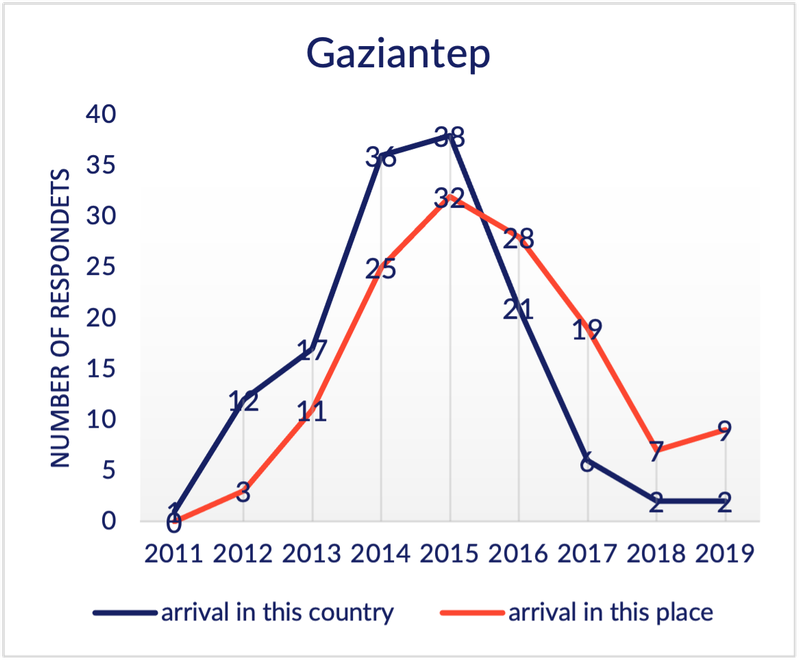
Figure 4: Istanbul – Year of arrival in Turkey and year of settlement in neighbourhood
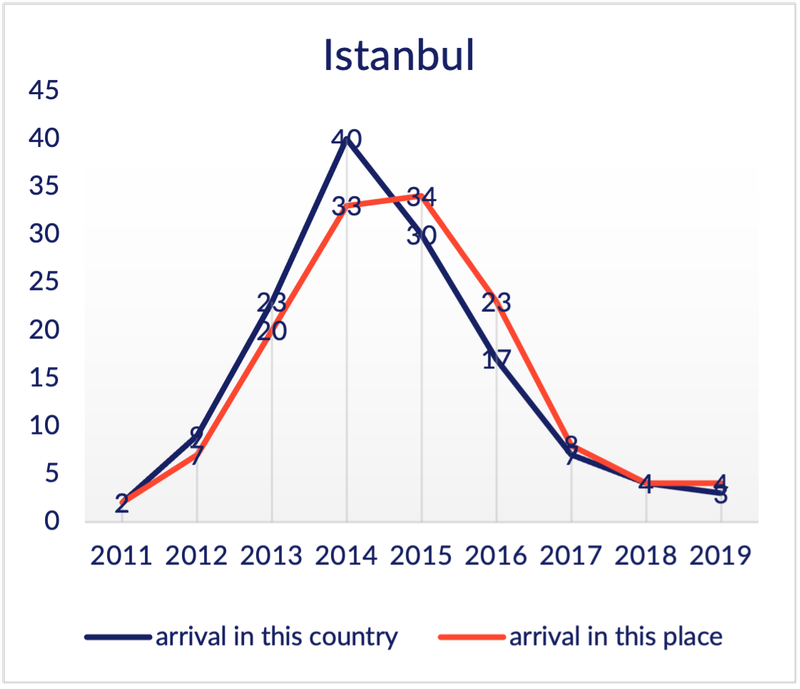
Kinship ties and networks are key factors influencing urban refugee settlement patterns
Although there is variation in the province of origin among Syrians refugees in Turkish cities, survey findings show strong linkages between Aleppo and Gaziantep based on geographic proximity, kinship, and business ties (see Figure 5). Gaziantep is also a Turkish hub for Syrians who still work in northern Syria and engage in cross-border activities. Due to perceived work opportunities and the presence of contacts or kinship ties, there was greater variety in the provincial origin of Syrians settled in Istanbul. For refugees with no ties within Turkey, Istanbul offered more job opportunities and anonymity. Some refugees from Damascus had connections or ties in Istanbul prior to 2011. Similarly, for many refugees from al-Hasakeh or other northern Syrian provinces, their family members from across the border in Turkey had settled in Istanbul before the war and thus attracted them to the city. As such, for a large number of Syrians in Turkey, kinship ties and networks were a key factor in settlement choices.
Figure 5: Distribution of respondents according to province in Syria

Neighbourhoods were chosen in Istanbul due to the presence of family and relatives (81%). However, in Gaziantep, the reasons were more varied: 51% settled due to family and relatives (mostly more distant relatives), 28% settled due to proximity to Syria, and 13% due to previous knowledge of the city.
In Istanbul, external factors influencing settlement decisions including the availability of employment opportunities (66%) followed by low cost of housing (22%). For respondents in Gaziantep employment opportunities were the primary factor (51%) followed by availability of public services (39%), and low cost of housing (35%) (see Figure 7).
Figure 6: Main attractions of the neighbourhood
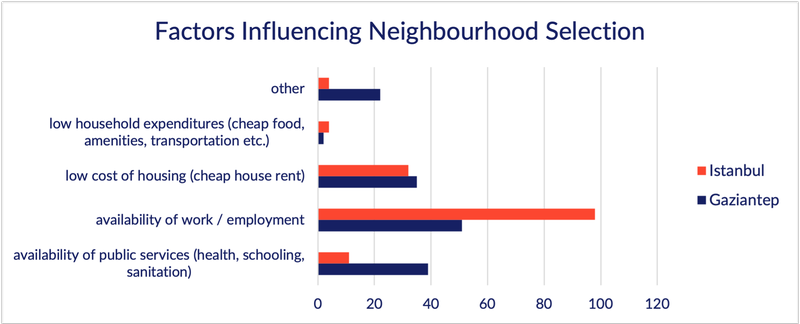
Simultaneously, employment was mentioned by (50%) of respondents in Istanbul as the main livelihood problem faced followed by housing (35%). Rising rents, availability of housing, and quality of housing were concerns. On the other hand, respondents in Gaziantep cited employment (33%), cost of housing (28%), and ‘other problems’ (23%). Apartments in the districts of Şahinbey and Şehitkamil in Gaziantep (surveyed by URBAN3DP) are sought after due to their central location. A high demand means that available apartments are often small and/or in older buildings.
Refugee households depend on household members’ economic participation and existing forms of support may only cover basis needs
Women were most likely to contribute to household livelihood if only one member of the household was working. However, this was not the case overall, and women generally had a limited role in gaining an income. For most respondents, at least one male family member was working. Respondents in Istanbul noted that rent took up the largest share of income followed by food expenditures. Meanwhile, respondents in Gaziantep highlighted the reverse, whereby food expenditures made up the largest share of expenditures followed by rent. Due to higher demand, rents in Istanbul are relatively higher than those in Gaziantep although food prices are comparable across cities. It is possible that respondents in Istanbul are resorting to negative coping strategies such as minimizing food expenditures to ensure rent when the primary expenditure is met. In parallel, families in Gaziantep may be living in smaller houses with lower rent whereby food constitutes the main expenditure.
Since 2016, the largest cash-based support programme for Syrian refugees under Temporary Protection has been the Emergency Social Support Net (ESSN).[6] ESSN involves monthly payments to refugees which they may use to meet their basic needs.
Based on the survey:
- Half of respondents in Istanbul and over half of respondents in Gaziantep received cash support.
- The Kizilay card (ESSN) was the most common type of cash assistance with (67%) of all respondents receiving cash assistance through it.
- Other sources of cash support mentioned include schooling allowance (Conditional Cash Transfer for Education [CCTE]) (15%), and food allowance (14%). Only 2% of households received a hardship allowance or housing allowance.
- Respondents receiving food or schooling allowance (CCTE) were more likely to also receive ESSN cash assistance.
- UN agencies are the main source for cash-based support according to respondents from Istanbul (62%) followed by government ministries (13%) and the municipality (13%), whereas (65%) of respondents in Gaziantep reported that government ministries were the main source of cash-based support followed by religious organizations or groups (22%).
On this last point, many programs supporting refugees in Turkey are funded through the EU Facility for Refugees in Turkey which funds governmental institutions, UN agencies, and INGOs to implement programs targeting both refugee and host-populations. In addition, many UN agencies carry out projects through local implementing partners. This may explain the divergence of funding-sources identified by respondents in the two cities.
Figure 7: Types of cash support distributed according to city
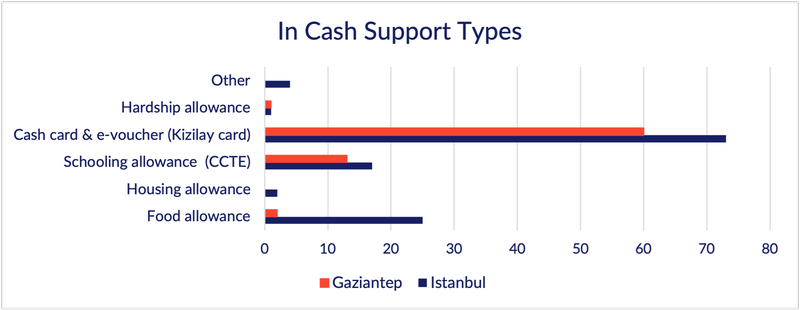
- In Istanbul, 32% of respondents stated that they received less than or equal to 500 Turkish Lira (TL); 54% received between 500-850 TL in terms of cash assistance; and 14% received over 850 TL.[7]
- For Gaziantep, 20% of respondents received less than 500 TL, 65% received between 500-850 TL, and 15% received over 850 TL.
- Cash-based support contributed to the household meeting its basic needs but were insufficient to cover all household expenditures (rent, food expenditures, etc.).
Respondents in Istanbul reported more diversity in the source of in-kind support[8] whereas only 6% of respondents in Gaziantep stated they had received in-kind support. In Istanbul, UN agencies constituted the largest provider of in-kind support (48%), followed by municipalities (25%), government ministries (12%), religious organizations (11%), and NGOs and community groups (4%).
Relations with host community vary between cities, but across Turkey social tension is related to demographic changes, worsening economic situation and lack of long-term integration policies
Turkish citizens were the dominant group in all the neighbourhoods surveyed. A higher percentage of respondents in Istanbul (24%) than in Gaziantep (1%) described their relations with host community members as being characterized by ‘avoiding contact’. Over half of the respondents in Gaziantep described the relations as ‘respectful’ while less than one third in Istanbul described them as such. However, in both cities, (3%) or less of respondents described relations as ‘unfriendly’ or ‘hostile’ (see Figure 8). These responses are noteworthy given the rising discrimination and social tension against the Syrian refugee presence in Turkey.
Figure 8: Description for relations with host community-based on number of respondents
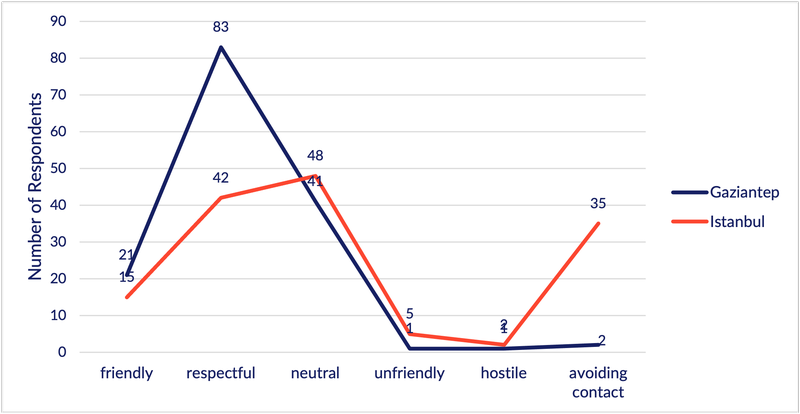
Return and resettlement intentions are affected by various factors, most importantly by living conditions
A higher number of respondents in Istanbul (81%) stated they would consider returning to Syria than those in Gaziantep (19%). An equal number of respondents in both cities stated they do not consider resettling to a European country (79%). When comparing the motivation for return or onward migration, the most commonly cited reason for respondents in Istanbul was living conditions while respondents in Gaziantep provided greater diversity in their responses mentioning: living conditions, cost of living, education opportunities, services (medical, health, etc.) and the availability of international assistance.
Conclusion
The Syrian forced migration to Turkey witnessed several policy changes over time which affect refugees’ access to services and choice of residence, among other issues. Employment and housing continue to be a concern for Syrian refugees as well as factors influencing the neighbourhood of residence. Similarly, current living conditions and perceived future opportunities in Turkey are key factors impacting refugees’ decisions to remain in the country or migrate.
Social cohesion and relations with the host comm-unity are another area where further efforts are needed. Different provinces across Turkey witnessed an increase in violence and discrimination against refugees indicating that existing efforts at developing social cohesion, organically or through local level efforts, require further adaption and modification. Longer term policies that support social cohesion must be developed, but further research is needed to identify what types of policies have been successful so far.
Turkey’s approach to Syrian refugees has depended on municipalities taking on new roles and duties in terms of developing programs or services for refugees, or expanding existing services to include refugee beneficiaries. While this trend has emerged across the region, the Turkish case is distinguished due to the centralization of the state. Despite this centralization, Turkey has also witnessed the development of international-local ties with international actors (e.g. UN agencies, INGOs) connecting with local governments to implement refugee inclusive projects. This trend is new to Turkey, developing with the protraction of Syrian displacement, although this approach has been adopted in other contexts of protracted displacement to address urban refugee needs.
Notes
[1] The term ‘Syrian refugees’ will be used in this briefing even though Syrians under Temporary Protection do not hold refugee status according to Turkish Law.
[2] Directorate General for Migration Management (DGMM), “Temporary Protection, Statistics.” 2022. Available from: www.goc.gov.tr/gecici-koruma5638; Also see, M. Murat Erdoğan, “Syrians Barometer 2019: A Framework for Achieving Social Cohesion with Syrians in Turkey”, Report, (Ankara: Turkish-Germany University, Migration and Integration Research Center).
[3] UNHCR and UNDP, “Regional Strategic Overview 2022”, Regional Refugee and Resilience Plan (Geneva: UNHCR and UNDP, 2022), p. 18. Available at: www.3rpsyriacrisis.org/wp-content/uploads/2022/02/RSO2022.pdf.
[4] The halting of registration and registration transfer in specific provinces means refugees who settle in these provinces cannot register or access services (e.g. healthcare, education, etc.).
[5] Syrian refugees crossing the border to Turkey must apply for Temporary Protection in the province of first arrival. Key provinces in Turkey including Istanbul and Gaziantep halted registration of new applications for Temporary Protection except for certain cases (e.g. newborns) in 2017. These provinces also stopped accepting registration transfer applications whereby refugees registered in another province cannot transfer to these provinces. Transferring registration is necessary for refugees to access services. Transfers are only accepted in certain cases such as to pursue higher education or marriage.
[6] ESSN can be accessed by non-Syrian refugees and asylum seekers. See Turkish Red Crescent, “Emergency Social Safety Net (ESSN)”, No. 17, Briefing (Istanbul, September 2021). Additional cash-based programs have been developed to complement the ESSN by supporting specific segments of the refugee population after the roll out of ESSN in 2016.
[7] At the time the survey was conducted, 500 TL was approximately 84 USD and 850 TL was approximately 144 USD.
[8] UN agencies do not implement projects directly, so implementation occurs through local partners and their offices. However, projects and programs usually advertise and highlight the funding agencies using various visual media to ensure visibility and prevent disinformation.
